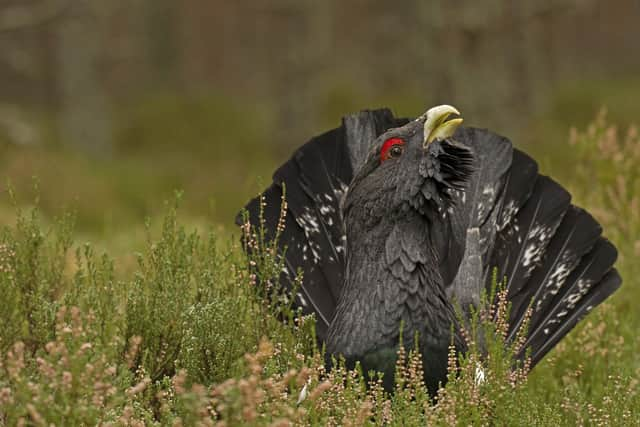Capercaillie numbers fall to critically low numbers, with less than 600 birds left in Scotland, survey finds
The population has dropped around 50 per cent since the previous survey six years ago and is now at a critically low level, the latest national survey has found.
Numbers of capercaillie have been declining since the third national survey of 2003/04. However, this is the first time the population has dipped below 1,000.
Advertisement
Hide AdAdvertisement
Hide AdConservation scientists said the decline is being fuelled by a combination of factors which reduce capercaillie survival and breeding success.


These include cold, wet spring weather, which has an impact on the fitness of female birds before the breeding season and affects chick survival, along with predation and a habitat that remains fragmented in places despite ongoing work to enhance it.
Experts are calling on agencies to work together to try to help the birds.
Nick Wilkinson, conservation scientist at RSPB Scotland, said: “This up-to-date estimate of capercaillie numbers reveals just how vulnerable the population in Scotland is.
“Previous surveys have seen numbers fluctuating between around 1,000 and 2,000 birds, so it’s really worrying that the results from last winter indicate there are only an estimated 542 individuals remaining now.
“These results will help focus efforts on where action should be targeted to help capercaillie by identifying their strongholds and where the most impact can be made for them.”
The country’s capercaillie population is surveyed every six years, and this – the sixth survey – was conducted over the winter of 2021/22.
The survey was funded by RSPB Scotland, NatureScot, Cairngorms National Park Authority, Cairngorms Capercaillie Project, Forestry and Land Scotland, and Scottish Forestry, with RSPB Scotland undertaking the fieldwork and scientific analysis of the results.
Advertisement
Hide AdAdvertisement
Hide AdIt comes after a study by the NatureScot Scientific Advisory Committee (SAC), published in February, warned the bird was likely to become extinct again in the UK within two to three decades if the trend in population decline continued.
The report said “renewed intensive measures” were needed if the population was to be conserved, focusing on options that would improve the survival of eggs and young chicks.
The UK capercaillie population is only found in Scotland, mostly in Scots pine forests that have a rich growth of blaeberry on the forest floor.
They are described as very shy and elusive birds, often perching in trees or hidden away on the forest floor.
It is estimated Cairngorms National Park has 85 per cent of the total population.
Andy Douse, NatureScot ornithology adviser, said: “It’s clear that the future of capercaillie in Scotland is extremely vulnerable.
“We recognise the urgency of the situation and the need to accelerate the partnership work that’s necessary to tackle threats to the species.”
Survey partners will be working with the Scottish Government to develop a strategy to reverse the decline, with a particular focus on the Cairngorms National Park area.
A Scottish Government spokesman said: “The results of the latest national survey are deeply concerning, despite the efforts made to enhance capercaillie habitats.”
Comments
Want to join the conversation? Please or to comment on this article.